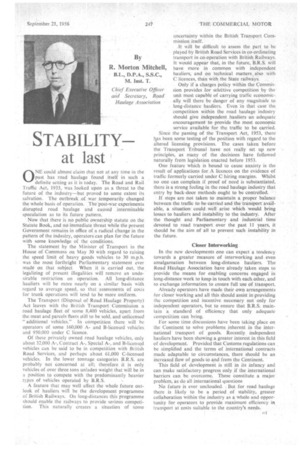STABILITY
Page 119

If you've noticed an error in this article please click here to report it so we can fix it.
at last
By
R. Morton Mitchell, D.P.A., S.S.C., M. Inst. T.
ONE could almost claim that not at any time in the past has road haulage found itself in such a definite setting as it is today. The Road and Rail Traffic Act, 1933, was, looked upon as a threat to the future of the industry—but proved to some extent its salvation.. The outbreak.of war temporarily changed the whole basis of operation. The.post-war experiments disrupted road haulage and caused interminable
speculation as to its future pattern. .
Now that there is no public ownership statute on the Statute Book, and no immediate threat while the present Government remains in office of a radical change in the pattern of the industry, operators can plan for the future with some knowledge of the conditions.
The statement by the Minister of Transport in the House of Commons on May 30 with regard to raising the speed limit of heavy goods vehicles to 30 m.p.h. . was the most forthright Parliamentary statement ever made on that subject. When it is carried out, the legalizing of present illegalities will remove an undesirable restriction on operation. All long-distance hauliers will be more nearly on a similar basis with regard to average speed, so that assessments of costs for trunk operations will tend to be more uniform.
The Transport (Disposal of Road Haulage Property) Act leaves with the British Transport Commission a road haulage fleet of some 8,400 vehicles, apart from the meat and parcels fleets still to be sold, and unlicensed "additional vehicles." In competition there will be operators of some 160,000 Aand B-licensed vehicles and 950,000 under C licence.
Of these privately ownedroad haulage vehicles, only about 32.000 A-, Contract A-, Special A-, and B-licensed vehicles can be said to be in competition with British Road Services, and perhaps about 61,000 C-licensed vehicles. In the lower tonnage categories B.R.S. are probably not concerned at all; therefore it is only vehicles of over three tons unladen weight that will be in a position to compete with the predominantly heavier types of vehicles operated by B.R.S.
A feature that may well affect the whole future outlook of hauliers will be the development programme 6: British Railways. On long-distances this programme should enable the railways to provide serious competition. This naturally creates a situation of some uncertainty within the British Transport Commission itself.
It will be difficult to assess the part to be played by British Road Services in co-ordinating transport in co-operation with British Railways. It would appear that, in the future, B.R.S. will have more in common with independent hauliers, and on technical matters. also with C licences, than with the State railways.
Only if a charges policy within the Commission provides for selektive competition by the unit most capable of carrying traffic economically will there be danger of any magnitude to long-distance hauliers. Even in that case the competition within the road haulage industry should give independent hauliers an adequate encouragement to provide the most economic service available for the traffic to be carried.
Since the passing of the Transport Act, 1953, there as been some testing of the position with regard to the altered licensing provisions. The cases taken before the Transport Tribunal have not really set up new principles, as many of the decisions have followed naturally from legislation .enacted before 1953.
One feature which is bound to cause anxiety is the result of applications for A licences on the evidence of traffic formerly carried under C hiring margins. Whilst no one can complain if proof of need is substantiated, there is a strong feeling in the road haulage industry that entry by back-door methods ought to be controlled.
If steps are not taken to maintain a proper balance between the traffic to be carried and the 'transport available, a situationcould well: arise which 'would bring losses to hauliers and instability to the industry. After the thought and Parliamentary and industrial time devoted to road transport over the past 11 years, it should be the aim of all to prevent such instability in the future.
Closer Interworking
In the new developments one can expect a tendency towards a greater measure of interworking and even amalgamation between long-distance hauliers. The Road Haulage Association have already taken steps to provide the means for enabling concerns engaged in long-distance work to keep in touch with each other, and to exchange information to ensure full use of transport.
Already operators have made their own arrangements for closer working and all this should assist in providing the competition and incentive necessary not only for independent operators, but to ensure that B.R.S. maintain a standard of efficiency that only adequate competition can bring.
For some time discussions have been taking place on the Continent to solve problems inherent in the international' transport of goods. Recently independent hauliers have been showing a greater interest in this field of development. Provided that Customs regulations can be simplified and the terms of international contracts made adaptable to circumstances, there should be an increased flow of goods to and from the Continent.
• This field of development is stilt in its infancy and can make satisfactory progress only if the international barriers can be overcome. These constitute a major problem, as do all international questions
No future is ever unclouded. But for road haulage there is likely to be a period of stability, greater collaboration within tile industry as a whole and opportunity for operators to provide maximum efficiency in transport at costs suitable to the country's needs.




































































































































































































































































































































